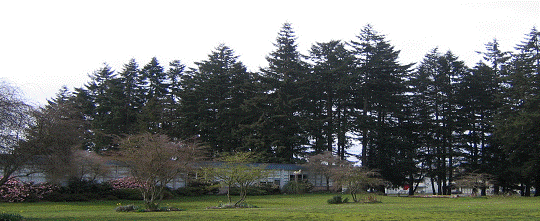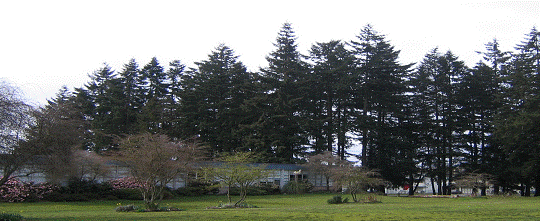
Threatened NW Tree Grove at Ingraham High School
Your comments now can help save the trees at Ingraham High School in North Seattle from the chainsaw!
If you have not yet heard, the Seattle School District has refilled their application to proceed ahead with their construction project at Ingraham High School. Here is the permit website: http://web1.seattle.gov/DPD/permitstatus/Project.aspx?id=3009549.
Comments need to be sent by Nov. 13, 2008!!! (note -deadline was extended)
The Seattle School District has filed to build the project in the same location as before – in the grove of 100 foot tall, 75 year old Douglas fir, Pacific madrone and western red cedar trees on the West side of the High School. This will result in the cutting down of 68 of the trees.
As you may remember, Save the Trees – Seattle was successful in temporarily stopping the Seattle School District from cutting down the trees in August after the District withdrew their permits. But the Injunction was only temporary and the school district has refiled with the Seattle Department of Planning and Development to go ahead with the Project.
The Judge at the time ruled that it was premature to file our appeal of the DNS (Determination of Non-Significance) on the Environmental checklist issued by the Seattle School District, even though the Seattle School District said we had to file then or lose our right to appeal.
Judge John Erlick of the King County Superior Court noted that the City of Seattle had the power to alter the project or put additional conditions on it and until the city approved the permit, the final project could be altered by the city. The Judge felt it was premature to rule on the merits of the case.
This is of course the hope of those opposing the trees being cut down and why your comments to the city are so important. The city has the option of saying the environmental impacts are significant in the proposed location that results in so many trees being cut down and ask the Seattle School District to move the project to another location.
Right now the Project has only been reviewed within the Seattle School District. Now it is the City of Seattle’s turn to review the Project for compliance with city laws, including our land use and environmental and SEPA laws. This is your opportunity to comment on the project and it is important that as many people as possible respond and urge the city to not approve the Seattle School District’s plan to cut the trees down. Comments must be sent by Nov. 13, 2008.
The fact is that there are other locations at Ingraham High School that the addition can be built on that do not require that any large trees be cut down, including the open lawn area on the North side of the school. They do not need to cut the trees down. Neighbors support the renovation which is to replace decaying portables at the school but not in the tree grove. We can have both education and trees on the Ingraham campus, which at 28 acres is the largest public high school campus in Seattle.
Important points to make to help save the trees:
1. Seattle’s latest Comprehensive Plan in the Environment Element states that the city should “strive to protect and retain certain trees and groups of trees that enhance Seattle’s historical, cultural, environmental and aesthetic values” and “work to achieve a sustainable urban forest that contains a diverse mix of tree species and ages in order to use the forest’s abilities to reduce storm water runoff and pollution, absorb air pollutants, provide wildlife habitat, absorb carbon dioxide, provide shade, stabilize soil, and increase property values.”
2. In addition the Comprehensive Plan’s policy is “to strive to achieve no net loss of tree canopy coverage starting in 2008, and strive to increase tree canopy coverage by 1% per year up to a total of 40 percent, to reduce storm runoff, absorb air pollutants, reduce noise, stabilize soil, provide habitat and mitigate the heat island effect of developed areas.” Seattle’s urban tree canopy has gone from 40% in 1972 to 18% today.
3. The west grove of trees at Ingraham HS was acknowledged by the Hearing Examiner for the Seattle School District to be a de facto park area used by students and neighbors for passive recreation and would be lost if the trees are cut.
4. SMC 25.05.675 N Plants and animals. City SEPA law states that it is “the City’s policy to minimize or prevent the loss of wildlife habitat and other vegetation which have substantial aesthetic, educational, ecological and/or economic value. A high priority shall be given to preservation and protection of special habitat types… A high priority shall also be given to meeting the needs of state and federal threatened, endangered and sensitive species of both plants and animals.”
5. The Washington State Department of Natural Resources through its Natural Heritage Program has classified the habitat in the west grove as a rare plant community in King County. The plant association includes Douglas fir, Pacific Madrone and salal. Pacific madrone trees are in decline in the region and need to be protected.
6. The band-tailed pigeon, which feeds on the fruit of the madrone tree, and has been seen in the Ingraham neighborhood, has been listed by the Washington Department of Fish and Wildlife as a priority species. “Priority species require protective measures for their survival due to their population status, sensitivity to habitat alteration ….”, according to the Department.
7. The Seattle City Council’s recently passed tree grove resolution stated that , “Section 25.05.675(N) of the Seattle Municipal Code allows for preservation of trees as mitigation when a project would reduce or damage rare, uncommon, unique or exceptional plant or wildlife habitat, wildlife travel ways, or habitat diversity for species of substantial aesthetic, education, ecological or economic value”
8. The Seattle School District’s DNS (Determination of Non-significance) is not a mitigated DNS. This means they are under no obligation to do anything they say they will do if they cut the trees – like plant more trees or protect the east grove of trees. The Seattle School District has a terrible record at Ingraham of trees dying that they previously planted.
9. Removing the trees creates drainage problems because the trees help control runoff and absorb water.
These are some points you can make but please write up in your own words your personal comments. Add any other reasons that you believe as to why the trees should be saved.
You can send comments 3 different ways:
1. Click on this link and you can just fill in your comments right now and send them in for the project. http://web1.seattle.gov/dpd/LUIB/CommentEmail.aspx?BID=358&NID=8971&P=3009549&D=10/16/2008
2. Send comments to: Tamara.Garrett@seattle.gov
3. Send comments to:
DPD/Attention Tamara Garrett
700 5th Avenue, Suite 2000
PO Box 34019
Seattle, WA 98124
Please include your name and address so you can be kept updated on the project, and be notified when there is a public meeting.Note the comments are on Permit Application #3009549 on the Ingraham High School Renovation.
Please send a blind copy – bcc to me at stevezemke@msn.com so that we can track the response and input we are getting if you send by separate e-mail and don’t use the form in the link above.
Even a few short sentences are helpful. We need to show strong public support from as many people as possible for saving the trees and moving the addition to another site, like the North lawn area at Ingraham.
The DPD on their website gives the following suggestions for making comments:
http://www.seattle.gov/dpd/Notices/Public_Comment/How_To_Comment/default.asp#Tips Tips on Making Effective CommentsAlthough the quantity of letters DPD receives regarding land use activities may indicate the extent of neighborhood or agency interest, it is the relevance of the comments—the information they contain—that will most affect a project’s outcome. Here are some tips on making your comments effective:
Briefly explain who you are and why you are interested in the project.
State your concerns clearly and succinctly using objective language.
Comment only on issues relevant to the decision being made.
State opinions and preferences, ask questions, and propose alternative solutions to particular issues. State informed opinions and, where possible, include data to support your opinion.
Review the project’s technical reports or Environmental Impact Statement (EIS) data, comment on conclusions, assumptions and the data collecting methods.
Keep focused on your objective. You want DPD to hear your concerns and be compelled enough to investigate further.
Identify the topics you want to include in your letter and how you want to organize them.
Ask for studies that you think are important but have not been provided.
If the proposed project is subject to SEPA and you think it will have significant environmental impact, request that an EIS be prepared.
Provide your own information.
Identify project features that you like and think should not be changed.
Provide any comments about the project’s compliance with the Land Use Code.
Ask to be added to the project mailing list and request a copy of the notice of decision. (Copies are sent via U.S. mail, s o please provide your mailing address when making request
For reference:
Here is the environmental checklist for the project:
http://www.seattleschools.org/area/facilities/BEXIII/Ingraham/2nd_revision_IngrahamSEPAChecklist.pdf
Here is the environmental policies and SEPA laws for Seattle:
http://clerk.ci.seattle.wa.us/~scripts/nph-brs.exe?s1=25.05&s2=&S3=&Sect4=AND&l=20&Sect1=IMAGE&Sect3=PLURON&Sect5=CODE1&d=CODE&p=1&u=/%7Epublic/code1.htm&r=1&Sect6=HITOFF&f=G
see also
www.MajorityRules.org/blog – numerous posts
http://saveingrahamstrees.info/About_Us.html
http://www.saveseattlestrees.org/Ingraham.htm
Judge halts Tree Cutting near Ingraham High School – http://seattletimes.nwsource.com/html/localnews/2008112745_trees14m.html
Judge – Tree Cutting at Ingraham High needs city approval – http://seattletimes.nwsource.com/html/localnews/2008138212_trees26m.html
Thanks for your help!
Steve Zemke
Save the Trees – Seattle
stevezemke@msn.com
206-366-0811
Please call if you have questions.
Please forward this link to others who might respond. Thanks
PS. Save the Trees – Seattle still owes about $4000 to their attorneys. If you can help with a contribution it would be appreciated. Checks can be made out to “Save the Trees – Seattle” and sent to Save the Trees – Seattle, c/o Steve Zemke, 2131 N 132nd St, Seattle, WA 98133
Please note revised date for sending in comments. The current updated date is by Nov. 13, 2008.











